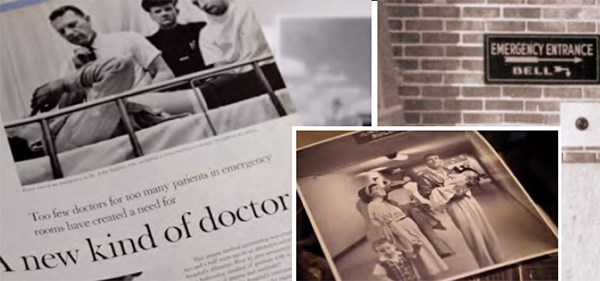“Anyone, anything, anytime.”
That offer — and pledge — of help is so embedded in our culture that nobody in residency today can remember a time before it. We don’t recall when the emergency room was nothing more than ill-maintained storage space (typically in the hospital basement). We weren’t around when emergency care was provided by unsupervised interns and off-hours dermatologists, if it was available at all. Or when they could turn patients away who did not have the ability to pay.
But as ACEP celebrates its 50th year and EMRA prepares for its 45th anniversary, we’re proud to honor those roots. We are a product of the ingenuity and sheer determination of the physicians of that era who imagined a better way – and then made it happen. (Watch our Emmy-winning documentary, “24|7|365,” for an eye-opening look at how our specialty began.)
They fought in the boardrooms and emergency rooms and lecture halls, steadily building up our credibility through research and policy and experience and results. After years of unwavering advocacy by the fledgling American College of Emergency Physicians, emergency medicine became the 23rd medical specialty recognized in the United States.1
In the years since that landmark event in 1979, EM has grown to include:
- 10 recognized subspecialties (plus fellowships in dozens more niches)2
- 240 EM residency programs3
- 53,000 board-certified emergency physicians4
- 137 million ED visits per year5 (and growing)
- EMTALA, the law that ensures we perform a medical screening exam on anyone who arrives in the ED
Emergency medicine has become the lifesaving safety net its pioneers wanted it to be. We keep the doors open 24/7, 365 days a year, for anyone, anything, anytime. But it’s not easy standing in the gap between patient needs and public policy. Just read the Medicare Payment Advisory Commission (MedPAC) report7 and you’ll get an idea of the weight of bureaucracy under which medicine now labors.
For a variety of reasons, hospital closures are on the rise.8 The emergency physician workforce is evolving.9 Physician burnout is being investigated as a contributing factor in medical errors.10 Our widespread use of ultrasound, procedural sedation, and trauma resuscitation are coming under fire from other specialties. Far too often, our specialty does not get the respect from patients, policy makers, and colleagues that it deserves. And through it all, more and more patients arrive at the ED.
In response, we’re finding more and more ways to meet their needs, through EMS advancements, ED-based ICUs, virtual health, freestanding EDs, urgent care, and ever-more-sophisticated training and education.
These challenges and others — government reimbursement, private insurance antics, internal strife — are not the same as the ones our specialty overcame merely to gain recognition. Yet at their core they still center on our pivotal point of unity: a desire to be the place people turn when they need help the most. Anyone, anything, anytime.
But we will only get there if we’re united and we all play our part.
Learning emergency medicine isn’t enough. We all need to find our leaders and blaze trails for those who will follow, whether it be in academia, community medicine, policy, business, or a subspecialty or niche of emergency medicine. That’s why, in honor of ACEP’s 50th and EMRA’s 45th, I humbly ask you to continue your service to your patients by serving your profession and consider applying for an EMRA Committee, writing a book with EMRA, giving a talk at an EMRA event, or just showing up — so that 50 years from now we can look back and smile a little bit wider at how far we’ve come in reshaping emergency care for Americans.
References
1. EMRA. 24|7|365: The Evolution of Emergency Medicine. Dallas, TX: Emergency Medicine Residents’ Association; 2015.
2. American Board of Medical Specialties. Specialty and Subspecialty Certificates. Accessed September 2018.
3. EMRA. EMRA Match. Accessed September 2018.
4. Statista. Number of active physicians in the U.S. in 2018, by specialty area. Accessed September 2018.
5. Centers for Disease Control and Prevention. Emergency Department Visits. Accessed September 2018.
6. Sahin AN. Quantifying US Residency Competitiveness in Different Fields. JAMA Intern Med. 2017;177(3):445.
7. The Medicare Payment Advisory Commission. Report to Congress. Accessed September 2018.
8. Flanagan C. U.S. Hospitals Shut at 30-a-Year Pace, With No End in Sight. Bloomberg. Aug. 21, 2018.
9. Hall MK, Burns K, Carius M, Erickson M, Hall J, Venkatesh A. State of the National Emergency Department Workforce: Who Provides Care Where? Ann Emerg Med. 2018;72(3):302-307.
10. Tawfik DS, Profit J, Morgenthaler TI, et al. Physician Burnout, Well-being, and Work Unit Safety Grades in Relationship to Reported Medical Errors. Mayo Clin Proc. 2018;pii:S0025-6196(18)30372-0.



